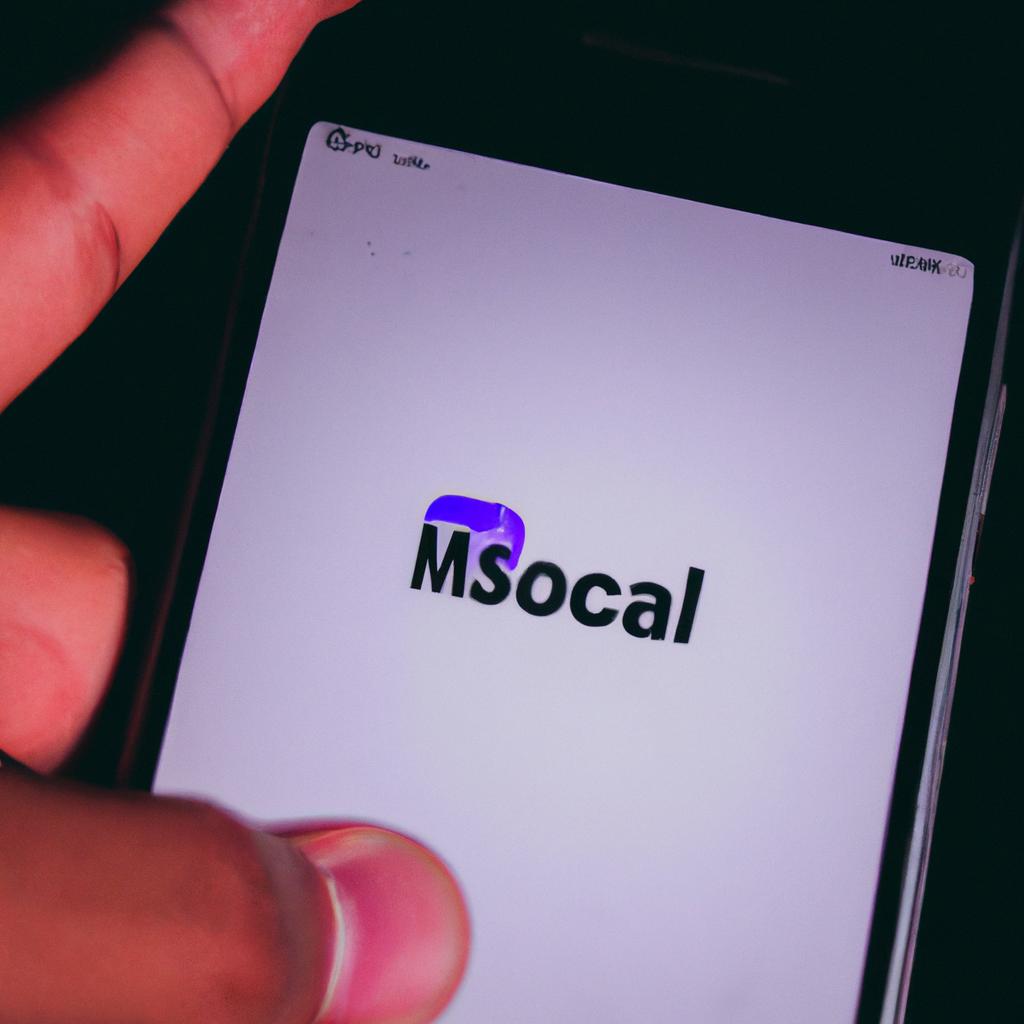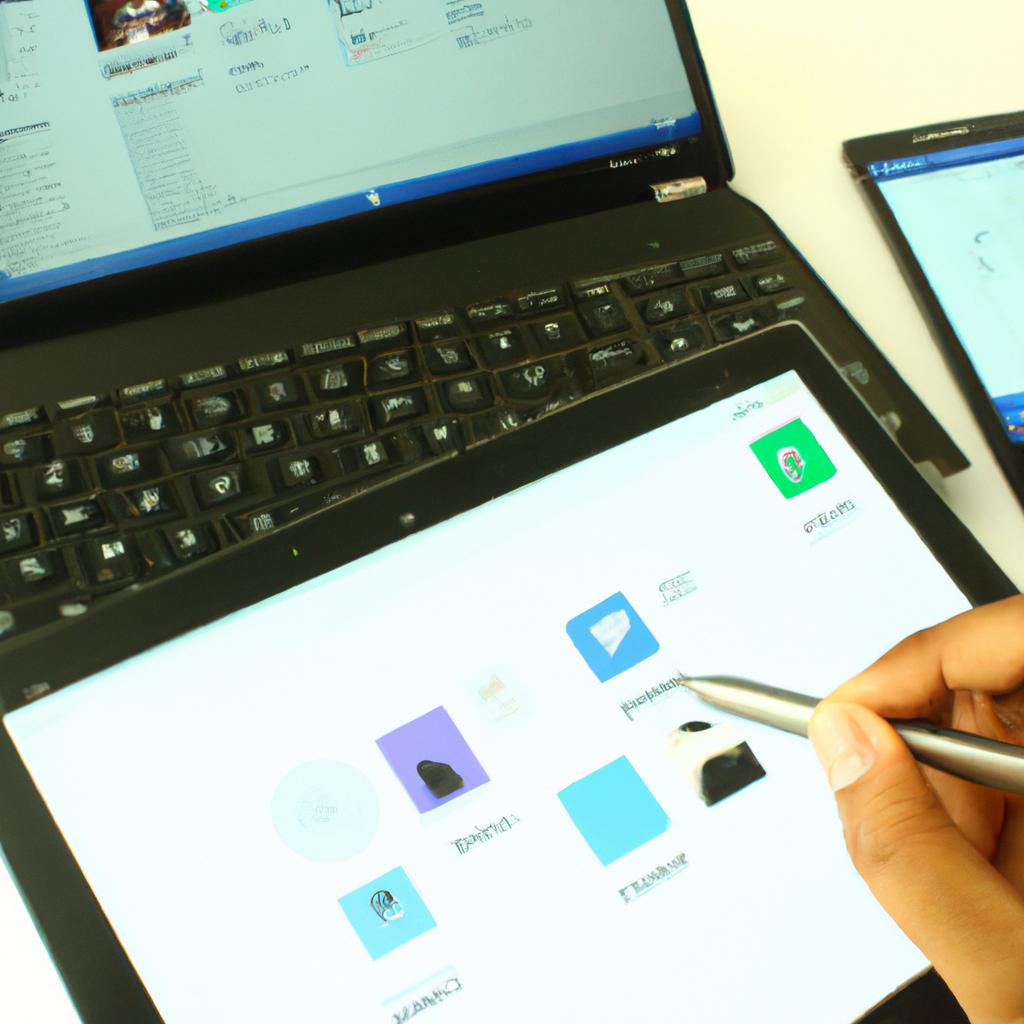Paid Social Advertising: Boosting Online Marketing & Advertising through Social Media Marketing

The rise of social media platforms in recent years has revolutionized the way businesses promote their products and services online. One effective strategy that has gained significant traction is paid social advertising, which involves utilizing paid advertisements on various social media channels to reach a wider audience and enhance brand visibility. For instance, consider a hypothetical scenario where an e-commerce company specializes in selling athletic wear. By leveraging paid social advertising on popular platforms like Facebook or Instagram, this company can target users who have shown interest in fitness or sports-related content, thereby increasing the likelihood of attracting potential customers.
Paid social advertising offers numerous advantages for businesses looking to bolster their online marketing efforts. Firstly, it provides access to highly targeted audiences, enabling companies to reach consumers who are more likely to be interested in their offerings. Through advanced targeting options such as demographics, interests, and behavior-based segmentation, businesses can optimize their ad campaigns to specifically cater to their desired customer base. Secondly, paid social advertising allows for precise tracking and measurement of campaign performance. With detailed analytics and reporting features provided by most social media platforms, marketers can gain valuable insights into key metrics such as click-through rates (CTR), conversions, and return on investment (ROI). This data-driven approach enables businesses to continuously refine their strategies and allocate resources more effectively, ensuring that their advertising budget is being utilized in the most efficient and impactful way possible.
Another advantage of paid social advertising is its ability to generate immediate results. Unlike traditional forms of marketing which may take time to yield tangible outcomes, social media ads can deliver instant visibility and engagement. With the right targeting and compelling ad creative, businesses can quickly attract attention, drive website traffic, and generate leads or sales.
Furthermore, paid social advertising offers flexibility and scalability. Businesses have the freedom to set their own budget and control how much they spend on ads. This allows for better cost management and the ability to scale campaigns up or down based on performance or business goals.
Lastly, paid social advertising provides opportunities for increased brand exposure through various ad formats such as image ads, video ads, carousel ads, and sponsored content. These visually appealing and interactive formats help capture users’ attention in a crowded online space, leading to higher engagement rates and improved brand recall.
In summary, paid social advertising has become an integral part of many businesses’ marketing strategies due to its ability to reach targeted audiences, provide accurate tracking and measurement capabilities, deliver immediate results, offer flexibility and scalability, and enhance brand exposure. By leveraging these advantages effectively, businesses can significantly boost their online presence and drive meaningful business outcomes.
Understanding Paid Social Advertising
Paid social advertising has become an essential component of online marketing and advertising strategies. With the rise of social media platforms such as Facebook, Instagram, Twitter, and LinkedIn, businesses are now able to reach their target audience more effectively through targeted ads. For instance, imagine a small clothing boutique that wants to promote its new summer collection. By utilizing paid social advertising on platforms like Instagram, they can specifically target fashion enthusiasts who follow similar brands or have shown interest in related content.
To better understand the significance of paid social advertising, it is important to recognize its key features and advantages. Firstly, this form of advertising allows businesses to increase brand visibility by reaching a larger audience compared to organic methods alone. Through paid promotion, companies can ensure that their content appears in users’ newsfeeds or timelines even if they do not already follow them. This increased exposure increases the likelihood of attracting potential customers who may be interested in the products or services being offered.
Secondly, paid social advertising offers precise targeting options that enable businesses to deliver tailored messages to specific demographics or user segments. Unlike traditional forms of advertisement where advertisements are displayed indiscriminately, paid social advertising allows for granular targeting based on factors such as age, gender, location, interests, behavior patterns, and purchasing history. As a result, businesses can create personalized campaigns that resonate with their intended audience and drive higher engagement rates.
Furthermore, another advantage of paid social advertising is its ability to provide measurable results through analytics and tracking tools provided by the platform itself. These tools allow businesses to monitor ad performance in real-time by providing valuable metrics such as impressions, clicks-through rates (CTR), conversions rates, cost per click (CPC), return on investment (ROI) among others. Such data-driven insights help marketers optimize their campaigns continuously and make data-informed decisions regarding resource allocation.
In summary, paid social advertising plays a vital role in boosting online marketing and advertising efforts. Its ability to increase brand visibility, deliver personalized messages, and provide measurable results make it a valuable tool for businesses aiming to enhance their online presence.
Emotional Response:
- Increased brand visibility
- Targeted messaging to specific demographics
- Real-time monitoring with analytics tools
- Data-informed decision making
| Benefit | Description |
|---|---|
| Increased Brand Visibility | Reach a wider audience through targeted ads |
| Tailored Messaging | Deliver personalized messages based on user demographics and interests |
| Real-Time Monitoring | Measure ad performance in real-time using analytics and tracking tools provided by platforms |
| Data-Informed Decision Making | Utilize data insights to optimize campaigns and allocate resources effectively |
Moving forward, let us delve into the numerous benefits that paid social advertising offers.
Benefits of Paid Social Advertising
Paid Social Advertising: Boosting Online Marketing & Advertising through Social Media Marketing
In today’s digital age, social media has become an integral part of our daily lives. It is not only a platform for connecting with friends and family but also a powerful tool for businesses to reach their target audience. One effective strategy that companies can employ is paid social advertising. To illustrate its impact, let us consider the case study of Company X, an e-commerce retailer specializing in fashion.
By utilizing paid social advertising on platforms like Facebook and Instagram, Company X experienced significant growth in online sales. Through targeted ads tailored to specific demographics and interests, they were able to capture the attention of potential customers who may have otherwise been unaware of their brand. This resulted in increased website traffic and ultimately higher conversion rates.
There are several key benefits that come with implementing paid social advertising as part of your marketing strategy:
-
Enhanced Targeting: With paid social advertising, you have the ability to precisely target your desired audience based on factors such as age, location, interests, and behaviors. This ensures that your message reaches those who are most likely to engage with your product or service.
-
Greater Reach and Exposure: By leveraging popular social media platforms like Facebook, Instagram, Twitter, or LinkedIn, you gain access to millions of active users worldwide. This broad reach allows your brand to be seen by a larger audience beyond traditional marketing channels.
-
Cost-Effective Solution: Compared to other forms of advertising such as television or print media, paid social advertising often offers more affordable options for businesses of all sizes. You can allocate your budget according to your needs and adjust it as necessary based on performance metrics provided by these platforms.
-
Measurable Results: Unlike traditional advertising methods where measuring success can sometimes be challenging or subjective, paid social advertising provides comprehensive data analytics tools. These insights allow you to track ad performance, engagement rates, click-through rates (CTR), and conversions in real-time.
| Benefit | Description |
|---|---|
| Enhanced Targeting | Precisely target your desired audience based on demographics, interests, and behaviors. |
| Greater Reach and Exposure | Gain access to millions of active users worldwide through popular social media platforms. |
| Cost-Effective Solution | Allocate your budget according to your needs with more affordable options compared to traditional advertising methods. |
| Measurable Results | Utilize data analytics tools provided by social media platforms to track ad performance, engagement rates, CTRs, and conversions in real-time. |
In summary, paid social advertising offers a powerful way for businesses to boost their online marketing efforts through strategic targeting, increased reach and exposure, cost-effectiveness, and measurable results.
Choosing the Right Social Media Platforms
Boosting online marketing and advertising through paid social advertising can greatly benefit businesses in reaching their target audience effectively. By strategically choosing the right social media platforms, companies can maximize their return on investment (ROI) and achieve higher conversion rates.
For instance, let’s consider a hypothetical case study of a clothing brand that decides to run paid social ads on Facebook and Instagram. This company targets young adults who are interested in fashion trends. With well-crafted ad campaigns that highlight their latest collection and offers exclusive discounts, they successfully capture the attention of their desired audience. As a result, they experience increased website traffic, higher engagement levels, and ultimately more sales.
There are several key advantages to utilizing paid social advertising for online marketing:
-
Enhanced targeting capabilities: Social media platforms allow advertisers to leverage advanced targeting options based on demographics, interests, behaviors, and even location. This level of precision ensures that ads are shown only to individuals who are most likely to be interested in the product or service being promoted.
-
Increased brand visibility: Paid social ads provide an opportunity for businesses to increase their brand exposure among both existing customers and potential prospects. Through strategic placement and consistent messaging, brands can establish a strong presence within their target market segment.
-
Improved engagement opportunities: Social media enables direct interaction between businesses and consumers. Paid ads often include call-to-action buttons or links that encourage users to engage further with the brand by visiting websites or making purchases directly from the platform itself.
-
Measurable results: Unlike traditional forms of advertising where it is difficult to track performance accurately, paid social advertising provides comprehensive analytics tools that offer insights into campaign effectiveness. These metrics help businesses evaluate ROI and make data-driven decisions for future marketing efforts.
| Key Benefits | Description |
|---|---|
| Enhanced Targeting | Advanced options allow precise targeting based on demographics, interests, behaviors, and location. |
| Increased Brand Visibility | Paid social ads help businesses gain exposure among existing customers and potential prospects. |
| Improved Engagement | Direct interaction with consumers is facilitated through call-to-action buttons or links in the ads. |
| Measurable Results | Analytics tools provide insights into campaign effectiveness to evaluate ROI and make data-driven decisions for future marketing efforts. |
By leveraging these advantages, companies can significantly enhance their online marketing and advertising strategies through paid social advertising.
Transitioning seamlessly into our discussion on “Targeting the Right Audience,” it is crucial for businesses to understand how to effectively reach their desired customer base through paid social advertising campaigns.
Targeting the Right Audience
Having identified the most suitable social media platforms for your advertising campaign, it’s now time to focus on targeting the right audience. By understanding who your ideal customers are and tailoring your messaging accordingly, you can increase the effectiveness of your paid social advertisements. Let’s explore some strategies that will help you reach and engage with your target audience effectively.
Targeting the Right Audience:
To illustrate the importance of targeting the right audience, let’s consider a hypothetical case study. Imagine you own an online fitness apparel store catering primarily to young adults interested in health and wellness. In this scenario, it would be crucial to ensure that your paid social ads reach individuals within this demographic group who have shown interest in fitness activities or related products/services. Reaching out to a broader audience might lead to wasted ad spend and lower conversion rates.
Here are some key strategies for targeting the right audience through paid social advertising:
-
Demographic Segmentation:
- Age, gender, location, and income level are important factors to consider when defining your target audience.
- Segmenting based on these demographics allows you to tailor your content specifically to appeal to different groups.
-
Interest-Based Targeting:
- Utilize data collected by social media platforms about users’ interests and behaviors.
- This allows you to refine your target audience further by reaching those who have expressed interest in topics relevant to your product/service.
-
Lookalike Audiences:
- Leverage existing customer data or website visitors’ information to create lookalike audiences.
- These audiences consist of people who share similar characteristics as your current customers or website visitors, increasing the likelihood of attracting potential customers.
-
Custom Audience Targeting:
- Upload customer lists or collect data from website visitors to create custom audiences.
- This enables you to target individuals who have already shown interest in your brand, increasing the chances of conversion.
By implementing these targeting strategies, you can maximize the impact of your paid social advertisements and improve conversions. Remember that audience segmentation is an ongoing process, requiring regular analysis and adjustment based on campaign performance metrics.
Now that we have discussed the importance of targeting the right audience, let’s delve into creating compelling advertisements that will captivate your desired viewership. Through engaging content and persuasive messaging, you can effectively communicate your brand’s value proposition and drive higher engagement rates.
Creating Compelling Advertisements
Transition from the previous section H2:
Having identified your target audience, the next step in maximizing the effectiveness of paid social advertising is creating compelling advertisements that capture their attention. By crafting engaging and persuasive content tailored to your audience’s preferences and needs, you can drive higher engagement rates and ultimately achieve better campaign results.
Section 3 – Creating Compelling Advertisements
To illustrate the importance of creating compelling advertisements, let’s consider a hypothetical scenario involving an e-commerce company specializing in athletic apparel. They have identified their target audience as fitness enthusiasts between the ages of 18-35 who are active on social media platforms such as Instagram and Facebook. In order to reach this audience effectively, it is crucial for them to develop ads that resonate with their interests and motivations.
In order to create advertisements that truly connect with your target audience, there are several key strategies to keep in mind:
- Tell a story: Craft narratives around your products or services that evoke emotions and resonate with your audience’s aspirations. For example, our hypothetical athletic apparel company could showcase individuals achieving personal fitness milestones while wearing their products.
- Use captivating visuals: Utilize high-quality images or videos that grab attention and communicate your brand message effectively. Visuals should be eye-catching, relevant, and aligned with your desired brand image.
- Highlight unique selling points: Clearly communicate what sets your product or service apart from competitors by emphasizing its unique features or benefits. This helps differentiate yourself in a crowded marketplace.
- Include clear calls-to-action (CTAs): Encourage immediate action from viewers by incorporating strong CTAs within your ad creative. Whether it’s signing up for a newsletter, making a purchase, or visiting your website, make sure the CTA is prominent and compelling.
These strategies can significantly enhance the impact of your advertisements when applied thoughtfully. To further exemplify these concepts, refer to the table below that highlights the key elements of successful paid social advertising:
| Key Element | Description |
|---|---|
| Compelling Visuals | Engaging and eye-catching images or videos that capture attention. |
| Emotional Appeal | Evoke positive emotions such as joy, inspiration, or excitement to establish a connection with your audience. |
| Clear Messaging | Concise and impactful copy that clearly communicates your brand’s value proposition. |
| Personalization | Tailor advertisements to specific audience segments, ensuring relevance and resonance. |
By incorporating these strategies and focusing on delivering compelling content, you can create ads that not only grab attention but also drive engagement and conversions.
Transition into the subsequent section: “Measuring and Optimizing Campaign Performance,” it is essential to monitor the effectiveness of your campaigns in order to make data-driven improvements for future success. Understanding how well your advertisements are performing allows you to optimize your targeting, messaging, and creative choices effectively without wasting valuable resources.
Measuring and Optimizing Campaign Performance
Optimizing Campaign Performance
Building compelling advertisements is just the beginning of a successful paid social advertising campaign. Once your ads are live, it’s essential to continuously measure and optimize their performance to ensure you’re maximizing your return on investment (ROI). Let’s explore some key strategies for measuring and optimizing campaign performance.
-
Track Key Performance Indicators (KPIs): To gauge the effectiveness of your paid social advertising efforts, it’s crucial to identify and track relevant KPIs. These may include metrics such as click-through rate (CTR), conversion rate, cost per acquisition (CPA), and return on ad spend (ROAS). By regularly monitoring these indicators, you can assess how well your campaigns are performing and make data-driven decisions for improvement.
-
Split Testing:
One effective way to optimize campaign performance is through split testing or A/B testing. This involves creating multiple versions of an advertisement with slight variations in elements such as headlines, visuals, or call-to-action buttons. By running these different versions simultaneously and comparing their results, you can determine which variation resonates best with your target audience and achieve higher engagement levels or conversions. -
Audience Segmentation: Another powerful optimization technique is segmenting your target audience based on various criteria like demographics, interests, behavior patterns, or purchase history. By tailoring your advertisements specifically to each segment, you can deliver more personalized messages that resonate better with individual users’ preferences and increase the likelihood of conversion.
The table below highlights the benefits of measuring and optimizing campaign performance:
| Benefits | Description |
|---|---|
| Enhanced ROI | Optimization allows you to allocate resources effectively towards high-performing ads resulting in improved returns on investment. |
| Better Targeting | Analyzing campaign data helps refine targeting parameters for increased relevance among potential customers. |
| Increased Conversions | Continuous measurement enables identification of underperforming areas leading to adjustments that boost overall conversions. |
| Cost Savings | Optimizing campaigns can reduce unnecessary spending on low-performing ads or ineffective targeting. |
In summary, optimizing campaign performance is a critical step in paid social advertising. By tracking KPIs, conducting split testing, and segmenting your audience effectively, you can refine your advertisements to yield better results. Remember that ongoing monitoring and adjustments are essential for maintaining the success of your campaigns.





